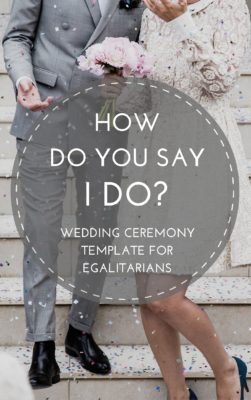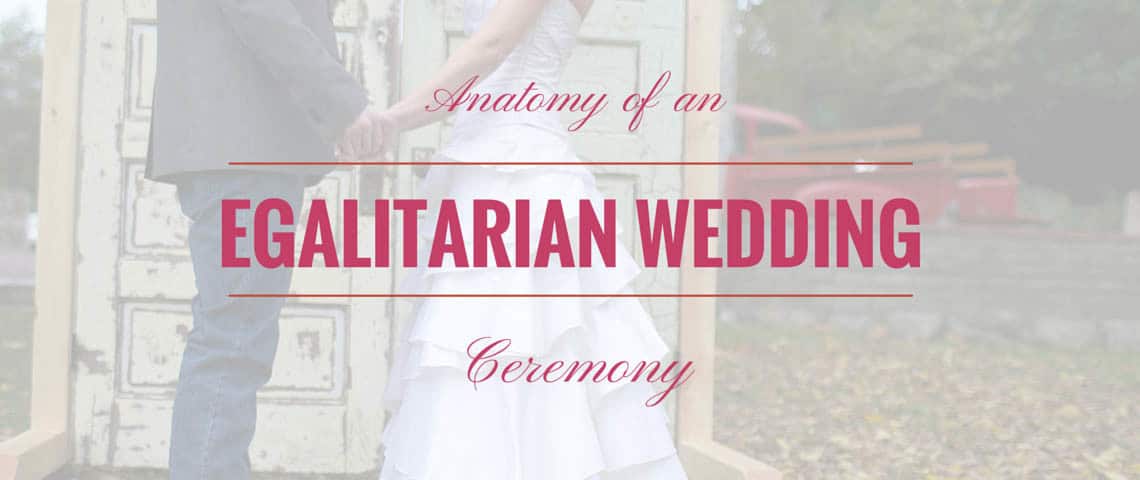Some time ago I was part of a Twitter conversation about marriage ceremonies that reflect biblical egalitarian values. Since my husband is a licensed minister and works on a college campus, we have had a LOT of experience with weddings, and I promised to share some ways we’ve seen egalitarian values incorporated.
As I was going through the notes from different ceremonies we’ve been a part of, I realized that there is more to this than just scripting the vows. If a couple wants their wedding to reflect egalitarian convictions, they must thoughtfully “dissect” each part of the ceremony and prepare some of the “stakeholders” involved.
Let’s start with stakeholders – those who may have an opinion or two about the ceremony.
THE FIANCE
This should go without saying, but if an egalitarian ceremony is important to you, make sure your future spouse is on the same page. Talk about what it might look like early on in the planning and be in agreement before you bring others into the picture.
THE MINISTER
You can easily script your vows to reflect your beliefs; it’s the unscripted parts of the ceremony that can get things off track. Since the minister will be in control of the ceremony, make sure he or she is on board. (Actually, if it’s a “she” you’re probably in good shape!) If the pastor has more traditional views, you may want to ask for an outline of remarks ahead of time.
THE VENUE
If you plan to be married in a church, ask about restrictions BEFORE you book. Some churches and denominations have strict policies about the wording of ceremonies and restrictions on who can perform a wedding in their building.
THE PARENTS
Parents may have a sentimental attachment to some wedding traditions, and deserve some consideration, especially if they are footing the bill. I’m more responsive to things when my children don’t dump them on me at all at once, so bring one thing up at a time. If they really object to something see if you can strike a compromise, or at least explain why this is important to you.
THE WEDDING COORDINATOR
I once attended a rehearsal where the wedding coordinator balked at the idea of both parents walking the bride down the aisle. But the more likely scenario is that this person can be an ally in making sure things go according to plan. Don’t leave this player out of the loop until right before the ceremony.
Now that we have that out of the way, what might a wedding ceremony that reflects an egalitarian perspective look like?
Here are the basic “bones” of a typical ceremony to consider:
MARCH DOWN THE AISLE
Some questions to consider: How will the bride and groom enter the room? Who will accompany the bride down the aisle? Will it be both parents, one parent, no parent? Also think about the wording that will be used after the minister welcomes the guests. Because “who presents?” or “who gives this woman…?” are throwbacks to an earlier age when the daughter was considered the property of the father, some couples opt for “who comes to bless this marriage?” and have all the parents respond with “We do.”
OPENING REMARKS AND HOMILY
If you’re not sure your minister is fully on board with your values, consider scripting the opening remarks, or have someone else give them. The same can be done with the homily (brief sermon) if you choose to include that. By law, the minister only has to administer the vows.
DECLARATION OF INTENT/VOWS/RINGS
The easiest thing here is to avoid liturgies that use different wording for the husband and wife. For example, some traditional vows call for the husband to “protect” and the wife to “obey”. There are several scripts like this available on wedding sites like “The Knot”.
SCRIPTURE READING
Look over the scripture passages that will be read, and check the translation rather than just the reference so you’re not surprised by an overabundance of male pronouns you weren’t expecting. Even better, print out the passages from the translation you prefer and have copies available.
ACTS OF UNITY (CANDLE LIGHTING, COMMUNION, ETC.)
I haven’t seen these as very problematic thankfully. After all, the very nature of such rituals is to emphasize mutuality and oneness!
PRONOUNCEMENT AND INTRODUCTION
“I now pronounce you husband and wife” is fairly standard these days, as opposed to the traditional “man and wife”, but you might want to check with the minister.
For the introduction some couples use both first names: “I now introduce for the first time, Mr. and Mrs. (Groom’s first name) and (Bride’s first name) Last Name. If you are keeping your own last names you could go with a simple “Please joining me in congratulating the newlyweds!”
FIRST KISS
Most weddings we attend end with the traditional “(Groom’s Name) you may kiss your bride”, which I see as fairly benign. An alternative might be something like “[Groom’s First Name] and [Bride’s First Name] you may take your first kiss as a married couple”.
No matter how carefully you plan, the reality is that weddings are rarely “perfect”.
With so many people involved and emotions running high it is likely that some part of the day is not going to go as you envisioned it.
In the end, the most important thing is your commitment to each other as full and equal partners, and that is not going to be impacted by anything that might not go according to plan in the ceremony.
~~~~~~~~~~~~~~~~
YOUR TURN: How would you design an egalitarian marriage ceremony? If you’ve been to an egalitarian wedding, what exactly made it egalitarian?
RESOURCES:
 Download our free PDF of an egalitarian wedding ceremony here.
Download our free PDF of an egalitarian wedding ceremony here.
http://bridalguide.com/planning/wedding-ceremony-traditions/examples-of-wedding-vows
http://soulation.org/jonalynblog/2012/08/egalitarian-marriage-what-it-looks-like.html
http://www.cbeinternational.org/blogs/proposals-parents-and-purchases/





34 Comments
Looks like I’m a year late, but I’m hoping I can receive the PDF of the egalitarian ceremony template? We’re trying to script our ceremony, but it’s been an overwhelming process, with few resources available! We just can’t handle obedience and submission in our ceremony. 🙂
Amanda, please email [email protected] and I’ll send it to you tomorrow!
Hi. I came across the Junia Project blog just a couple of months ago and it’s been very interesting so far and a good learning experience. I wanted to add something here that I hope won’t be too shocking to anyone. I’m Swedish, and most wedding ceremonies here include a radically egalitarian component in that the bride and groom walk down the isle together. The message sent, so to speak, is that “here are two mature people who have come to the mutual decision that they want to get married”.
Thanks for an interesting post. /Emmy
Emmy, that is a great reminder of something we didn’t say in the post, which is that wedding traditions are very culturally specific! I appreciate how egalitarian Sweden is in general – far ahead of the U.S. I like this tradition you’ve share and the message it represents. Thank you for taking the time to share!
Great suggestions! You mention the unity candle as a fairly benign tradition and I agree, however I do have a few thoughts on the symbolism. When my husband and I married, I was informed by a guest after the service that we did the unity candle “wrong”. She stated that we should have each blown our candle out after we lit the unity candle signifying our oneness. I pondered that a moment and then said, “Oh, well, I like the way we did it! I don’t think I want to blow my candle out!” Fifteen years later as a Licensed Marital and Family Therapist, I have to say I think my instinct was on track – healthy marriage provides the ability to be a unit without losing all sense of one’s self, certainly the symbol of our two lights joining to create a unified light is a lovely symbol but we did not cease to be individuals with individual lights when we decided to share our light with each other – there is plenty of room for both of our lights to shine and to contribute to a unified light. I also think this is a more egalitarian symbol for me – my light did not become consumed by his light at our marriage – together we create a new and bright story that still leaves room for each of our individual hearts, minds and stories.
When I married less than two years ago, my grown daughters from my first marriage walked with me down the aisle (and stood up with us as our attendants.) The minister asked, “Who welcomes [my husband’s first name] into this family?” And my daughters, choking back tears, said “We do!” Many people said it was their favorite part of the wedding. We wanted to show how he was being grafted into our family!
LOVE IT! Thanks for sharing 🙂
I have to share a funny story from a wedding I was at (names changed): After the minister had given a very non-egalitarian homily and was ready to present the couple he said, “I’d like to present to you for the first time, “Mr & Mrs Dan Smith.” My cheeky friend leaned over to me and said, “OH I didn’t know Claire changed her FIRST name too!”
I always laugh at this memory when ministers do this at weddings (:
Too bad it would have been inappropriate to say it loudly! Great story 😉
Pick up a Presbyterian Church (USA) United Methodist, Episcopal, or Lutheran book of worship. They all have prayers/vows/other acts of worship that are egalitarian in nature. In the United Methodist Church, we are not allowed to use asymmetrical vows. So, even if you are in a more evangelical or less liturgical tradition, the resources of these denominations can be really helpful.
Great advice, Lauren!
Lots of great ideas here. THANKS! May every couple planning a wedding see them. My husband and I officiated together in our boys’ weddings and the whole family walked Karmelle down the aisle in hers.
Last weekend I heard about an APU wedding that was dominated by submission language, obedience, husband as ‘executive decisor,’ etc. etc.
When my daughter was married, her father walked her down the aisle. I was already up front waiting to perform the ceremony. The wedding venue folks seemed a bit unsure at first about how to deal with the bride’s mother as minister, but they handled it well. For me, it was one of the most moving moments of my life. I saw every giggle, every tear, the tremble in their hands, and the look in their eyes!
Gail, thanks as always. I will keep your recommendations the next time I perform a wedding ceremony. I appreciated the scripting and options, and all the thoughtfulness you put into considering the feelings of all involved.
Thank you, Grace!
My fiance and I are planning to arrange the seating in concentric circles with two aisles leading to the center. This way we EACH get to have our aha moment. It’s easier to do this with our outdoor, forrest venue. We also are being married by a couple, not just a single person. Thanks for sharing these ideas and healthy reminders!
Are there books on egalitarian marriage that you’d recommend? My loving aunts and uncles continue to suggest Love and Respect as an important book to read as we prepare for marriage. They are generous with their advice and I’m feeling like I need to replace gendered instructional books with contemplative, truth-seeking ones. (Sorry if that’s too off topic!)
Love these creative ideas, Mackenzie. Thanks for sharing. As far as books, there are some listed here to check out 🙂
http://newlife.id.au/equality-and-gender-issues/equality-in-marriage/egalitarian-books-on-marriage/
How interesting to read. My mother bought me my dress and veil and accessories as a suprise, and my dad walked me down the aisle looking so proud, he was so nervous and the church so tiny we ended doing a quick step, and nearly ended up in the flower arrangements!
It meant so much to my mum to spend her money on me, as she had finally got a more equal state with dad who was old fashioned but very caring, and had a part time job and car and finally investments! and I couldn’t have taken that day away from dad, he was so pleased with the quality of my future husband for my sake, that he beamed and blushed more than I did…I was 30 ….and never pressured about marriage or grand children by my mum and dad.
We took out obey, but our beloved minister forgot, so I said yes, winked at my husband, and more than a few friends giggled a little, they knew us better than that!
My wedding was as I wanted, ata country venue that suited us both, we planned a lovely service and had a sit down meal that was just simple and easy to serve.
Such a great day, many said it was the best they had been to. The fact that the bridegroom was tipped upside down and covered with confetti as we left for out honeymoon was a glimpse of the fun and spontenaity of the day…30 years ago this March, feels like 3 years!
When my husband and I got married, we kept the ‘who gives this woman?’ line. However, my father said “she gives herself, and we joyfully share in her happiness.” That was followed by “who gives this man to be married to this woman?” and his father said “He gives himself, and we joyfully share in his happiness.”
I LOVE THIS! Thanks so much for sharing 🙂
I wasn’t too concerned about this during our wedding. I was much more concerned about budget and keeping things as simple as possible. We did most of the “traditional” wording during the ceremony, to keep things easy but it wasn’t old fashioned or sexist wording. I did have both of my parents walk me down the aisle because I never felt okay with having my Dad be the representative when both were equally responsible raising me and I felt that it is more symbolic of moving from my childhood family to my new life/family in marriage, not so much of a giving away like property. I think a lot of it is probably depending on the perspective of the couple. We also didn’t get married in a church so there were no issues with conforming to their requirements (we got married at APU 🙂 .)
I love your perspective on the reason to have both parents involved in the presentation – that it’s symbolic of moving from your childhood family to your new life and starting your own family. So much of this is one’s perspective, as you mentioned. And I’d love to hear more about your APU wedding one day!
My husband and I wrote an article for CBE’s “Mutuality” several years ago about how we planned our wedding. http://www.cbeinternational.org/sites/default/files/ido_snyder.pdf
(and I just noticed you linked to our blog post!)
🙂
Great article, thanks! I’m getting married in 6 months, and this was very helpful 🙂
Congratulations, Emily! There are some great ideas here in the comments to build on as well. Be sure to subscribe to get the PDF of a vows template!
One of my best friends got married in the Episcopalian tradition last fall and it was probably the most awesomely egalitarian wedding I’ve ever attended. She was worried about all the things mentioned above but was told by the minister not to worry, the wedding liturgy was very different from ‘traditional’ wedding ceremonies. Both parents walked both bride and groom down the aisle as a part of the procession and instead of ‘you may kiss the bride’ it was something like ‘you may greet each other.’ other differences really focused the ceremony less on the couple and more on Christ. (photos here if you’re curious 🙂 http://clients.photojj.com/kali_brent_wedding/h8065D7C#h1df562f2)
Well I have seen soooo many different ways ceremonies have been done, but one thing I have done a few times and like to tell couples about that fits in here, is when the bride and her father get to the end of the aisle, the father moves to the other side of the bride and the mother joins him, and the groom comes next to the bride with his parents on the other side of him, and rather than a “giving away” moment, the minister then asks the parents to commit to supporting this new marriage and the parents all together say “we do”, this is sometimes followed by a prayer with all of them standing together, then there are usually some hugs and kisses exchanged and then the parents sit down and the bride and groom step forward!
And I appreciate your coordinator comment! I always try to find out as much as possible before when it comes to the hopes of the bride and groom for how they want their ceremony to flow, and also their values and beliefs when it comes to what will be said and how things should go. My goal is to be their best advocate during the rehearsal and wedding day!
Megan, I’m kicking myself for not asking you to co-write this piece with me! Please consider writing a “tips from a wedding planner” for our audience! Thanks for sharing these ideas for the presentation part of the ceremony.
Oh that would be fun! I will think about it! 🙂
This is very interesting, thanks! When I got married I didn’t know much compared to now (from either life experience or from study), but I did realize I didn’t want to be “given away” or vow to obey. I made arrangements with my bemused and amused father and groom to avoid the former, and arrangements with our amused minister not to say “obey” in the vows. He refused to promise not to say it, so I told him I wouldn’t take the vows if he said it, and that’s the way we left it for the wedding day. Now I see how disrespectful that was. Why not say one way or the other? Just wanted to keep me in suspense, I guess, and have a sense of control. He didn’t say “obey” when the time came though. I was serious; I wouldn’t have taken that vow.
But I’ve been glad ever since that I did those things. No regrets. Just glad relief.
Zoe, what a crazy story that is! I love the way you responded and held your ground, which led him to respect your wishes – or at least not risk the embarrassment of what might have happened! But yes, that was very disrespectful and a power play on his part, really. Glad it turned out well – that could have been a very difficult situation. Thanks for sharing your story!